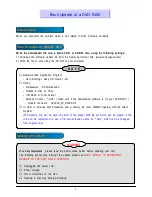
3
CFD-S35CP
TABLE OF CONTENTS
1.
SERVICING NOTES
................................................
4
2.
GENERAL
...................................................................
5
3.
DISASSEMBLY
3-1.
Cabinet Top Assy .............................................................
7
3-2.
Cabinet Front Assy, Cabinet Rear Assy ...........................
7
3-3.
Wires ................................................................................
8
3-4.
MD Block ........................................................................
8
3-5.
Holder Cassette ................................................................
9
3-6.
POWER KEY Board .......................................................
9
3-7.
MAIN Board .................................................................... 10
3-8.
TUNER Board, POWER Board ...................................... 10
3-9.
CD Lid ............................................................................. 11
3-10. LCD Block Assy .............................................................. 11
3-11. CD Block Assy ................................................................ 12
3-12. Optical Pick-up ................................................................ 12
3-13. R/P Head (HRP301), Erase Head (HE301), TC Board ... 13
3-14. Motor Assy (M801), RF Belt .......................................... 13
4.
MECHANICAL ADJUSTMENTS
......................... 14
5.
ELECTRICAL ADJUSTMENTS
Tape Section .................................................................... 14
Tuner Section ................................................................... 15
CD Section ...................................................................... 17
6.
DIAGRAMS
6-1.
Block Diagram – CD Section – ...................................... 19
6-2.
Block Diagram – TUNER-2 BAND Section – ............... 20
6-3.
Block Diagram – TUNER-3 BAND Section – ............... 21
6-4.
Block Diagram – MAIN Section – ................................. 22
6-5.
Printed Wiring Board – MP3-CD Section – ................... 24
6-6.
Schematic Diagram – MP3-CD Section – ...................... 25
6-7.
Printed Wiring Board – TUNER-2 BAND Section – ..... 26
6-8.
Schematic Diagram – TUNER-2 BAND Section – ........ 27
6-9.
Printed Wiring Board – TUNER-3 BAND Section – ..... 28
6-10. Schematic Diagram – TUNER-3 BAND Section – ........ 29
6-11. Printed Wiring Boards – MAIN Section – ..................... 30
6-12. Schematic Diagram – MAIN Section (1/2) – ................. 31
6-13. Schematic Diagram – MAIN Section (2/2) – ................. 32
6-14. Printed Wiring Board – TC Section – ............................. 33
6-15. Schematic Diagram – TC Section – ............................... 34
6-16. Printed Wiring Boards – CONTROL Section – ............. 35
6-17. Schematic Diagram – CONTROL Section – .................. 36
6-18. Printed Wiring Boards – POWER Section – .................. 37
6-19. Schematic Diagram – POWER Section – ...................... 38
7.
EXPLODED VIEWS
7-1.
Cabinet Section ................................................................ 46
7-2.
Cabinet (Front) Section ................................................... 47
7-3.
Cabinet (Top) (1) Section ................................................ 48
7-4.
Cabinet (Top) (2) Section ................................................ 49
7-5.
Cabinet (Rear) Section .................................................... 50
7-6.
Tape Mechanism Section (MF-S350) .............................. 51
7-7.
CD Mechanism Section (KSM-213CDP) ....................... 52
8.
ELECTRICAL PARTS LIST
.................................. 53
•
UNLEADED SOLDER
Boards requiring use of unleaded solder are printed with the lead-
free mark (LF) indicating the solder contains no lead.
(Caution: Some printed circuit boards may not come printed with
the lead free mark due to their particular size.)
: LEAD FREE MARK
Unleaded solder has the following characteristics.
• Unleaded solder melts at a temperature about 40
°
C higher than
ordinary solder.
Ordinary soldering irons can be used but the iron tip has to be
applied to the solder joint for a slightly longer time.
Soldering irons using a temperature regulator should be set to
about 350
°
C.
Caution: The printed pattern (copper foil) may peel away if the
heated tip is applied for too long, so be careful!
• Strong viscosity
Unleaded solder is more viscous (sticky, less prone to flow)
than ordinary solder so use caution not to let solder bridges
occur such as on IC pins, etc.
• Usable with ordinary solder
It is best to use only unleaded solder but unleaded solder may
also be added to ordinary solder.
Summary of Contents for CFD-S35CP
Page 18: ...18 CFD S35CP MEMO ...




































